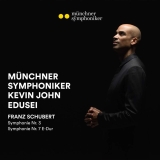Kevin John Edusei und die Münchner Symphoniker setzen ihren äußerst beachtenswerten Schubert-Zyklus mit den Symphonien Nr. 3 und 7 fort.
Die 3. Symphonie D-Dur D. 200 hat Schubert 1814, im Alter von 17 Jahren komponiert. Sie steht noch ganz im Geiste Haydns und Mozarts, hat aber schon viel Persönliches aufzuweisen, so z.B. die Einleitung Allegro maestoso, die Edusei sehr intensiv gestaltet, so dass sich das anschließende Allegro con brio umso kontrastreicher davon abhebt. Und wie schon in den vorherigen Aufnahmen ist es wieder das federleichte und elastische Musizieren der Münchner Symphoniker, das auf Anhieb fasziniert. Transparenz, wunderschön ausgeformte lyrische Linien und frische Farben kennzeichnen auch das Allegretto und die beiden letzten Sätze, die mit viel Virtuosität gespielt werden,
Ab der Siebten ist die Nummerierung der Schubert-Symphonien verwirrend. Als Nummer 7 wird oft noch die sogenannte Unvollendete aufgelistet, manchmal auch noch die Große C-Dur Symphonie, die Neunte. Heute ist die Nummer 7 für jene Symphonie in E-Dur reserviert, die im August 1821 entworfen wurde. Obwohl das viersätzige Werk strukturell vollständig ist, hat Schubert nur die ersten 110 Takte orchestriert. Schubert scheint die Symphonie beiseitegelegt zu haben, um an seiner Oper Alfonso und Estrella zu arbeiten und ist nie wieder zu diesem Werk zurückgekehrt. Es gibt mindestens drei Vervollständigungen: von John Francis Barnett (1881), Felix Weingartner (1934) und Brian Newbould (1980). Für diese letzte Version hat sich Kevin John Edusei entschieden. Der Dirigent gibt dem Werk ein Maximum an Wärme, Durchsichtigkeit und Dynamik. Besonders schön und einfühlsam wird der zutiefst romantische langsame Satz gespielt.
Kevin John Edusei and the Munich Symphony Orchestra continue their remarkable Schubert cycle with Symphonies Nos. 3 and 7.
























